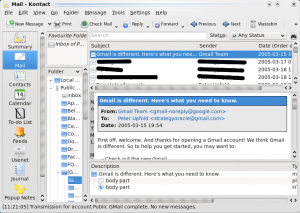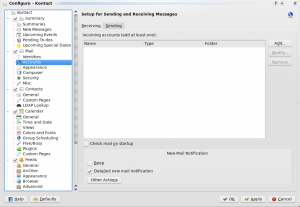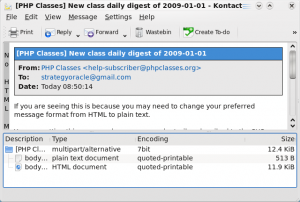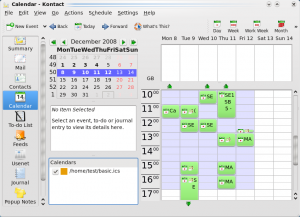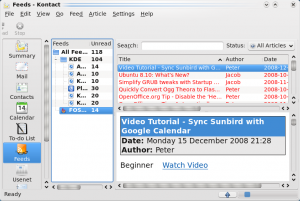
Welcome back to Part 2 of this series - pitting GNOME's Evolution Personal Information Manager (PIM) suite against KDE's Kontact.
If you haven't read Part 1, please take the time to do so, as I'll be making quite a few comparisons between Evolution, covered there, and Kontact.
Now, we continue with KDE's Kontact.
Kontact

Interface
Kontact's interface has some similarities with that of Evolution. One of the most striking differences is the fact that in many areas there are three sidebars.
On the far left you have a sidebar for switching between the different sub-applications - Mail, Contacts and the like, and then in Mail, you'll have another sidebar for your mailboxes and then a main area split into a message list and the preview pane.
The addition of this triple-vertical-pane approach for me makes the interface a lot more cluttered and less easy to pick up straight away.
Certainly, though, it feels less like an absolute copy of Outlook than Evolution; it feels like an application developed for KDE, rather than a clone of something else that is just ported over. Where Evolution feels a bit like a GNOME slant on a Windows app, Kontact really does feel very much an integral part of KDE.
It's worth mentioning as well that Kontact is quite literally, a collection of distinct KDE apps that are simply stitched together into a single application. Unlike Evolution, it is possible to launch each component, or 'part' in KDE terminology, as a separate application on your desktop.
One thing that really bugs me about the KMail part of Kontact is the fact that by default, it only shows you messages in plain text view.
I fully appreciate why you'd want to send email as plain text and why you might prefer reading email as plain text, but the fact that it is so incredibly difficult to read an HTML-formatted message out of the box is infuriating.
In terms of searching, KMail sadly lacks an advanced full text message search as far as I can see. The toolbar-based search works fine, though, if you only need to search message subject or sender.
Calendaring and Sharing
The Calendar module is similar to Evolution's, although it does sport the three-pane layout which I don't like. You can share events with others through the context menu; starting a new message with an attached .ics of the event. This works more smoothly than Evolution - and you can actually type a message in the body!
Interestingly, this time I experienced a crash importing an ICS file into an existing calendar, but I had no problem making a new calendar with my exported events from Google Calendar. In addition, the Google Calendar specific CalDAV support didn't work either.
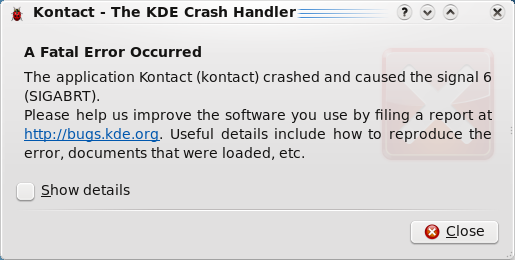
Extra Features
I'm going to diverge from my self-imposed structure for just a moment here. One of the best features of Kontact is that it is relatively easy to bolt a new KPart into the application. I particularly am impressed with the Feeds module; a example of this - taking the standalone Akregator application for KDE and putting it into a Kontact.
Having support for RSS news feeds in an application like this I think is an excellent idea, allowing you hopefully to bring together all of the information you care about into a single applciation.
There are also several other modules available that Evolution lacks, including a Journal and support for Usenet newsgroups.
Integration
Within the suite itself, Kontact has a similar level of integration to Evolution. You can obviously send a calendar event in Mail, access your Contacts from any part of the app and so on.
A nice feature which increases the utility of the suite is that any alarms you have set for events in your calendar can erm... go off even if the application is closed. The Calendar - and therefore alarms - part of Kontact is handled by KOrganiser, which runs a daemon which sounds the alarm even without needing Kontact open.
Kontact also feels very much like a first-class citizen on the KDE desktop. It behaves like other KDE applications do and brings a lot of functionality together to try and become the information hub of your KDE desktop.
Conclusion
So regardless of their desktop environment, which of these suites solves this PIM problem better? Of course, a lot of this is going to come down to personal opinion.
I think mine is clear, however. Despite being a KDE user for most of my time on Linux, I have found that I do prefer Evolution.
Yes, yes, I don't like how it feels very much like an Outlook clone, but the interface is just a whole lot cleaner than Kontact. KDE's philosophy of giving the user endless configurability makes Kontact's interface (and particularly its configuration) very cluttered and confusing unless you are already familiar with it.
The feed reader functionality in Kontact is excellent, however, and adding this into a single 'information dashboard' I think could be extremely useful. Unfortunately, this doesn't make up for the fact that the rest of the Kontact interface feels too complex and sometimes a little bit... well... old-fashioned (plain text email? I agree, but I do need to read HTML mail sometimes).
If you are a die-hard KDE user and you are very familiar with the way that KDE interfaces tend to work, you may well find Kontact to be the better choice. Particularly if you have already put a lot of investment into KDE applications, the integration of them into a single suite is very useful and an admirable achievement.
For me, though, Evolution wins this PIM battle. It might be a bit Outlook-alike (if you'll excuse the pun), but it just... feels better.
Not that I'll be switching to it. Despite writing this article and having had a good play with both, I actually still prefer keeping applications of this nature separate, so I'll be continuing to use Thunderbird for my IMAP email when I'm on Linux (under KDE, I might add).
